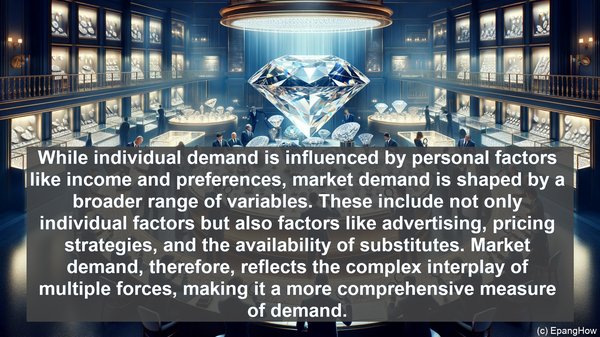Introduction: The Dynamic World of Demand
Greetings, audience! The realm of economics is replete with intriguing concepts, and demand is undoubtedly one of them. Today, we’ll be focusing on two facets of demand – individual demand and market demand. While they may seem similar, there are crucial distinctions that we’ll be exploring. So, let’s dive in!
Defining Individual Demand: The Consumer’s Perspective
Individual demand pertains to the quantity of a product or service that a single consumer is willing and able to purchase at a given price, within a specific time frame. It is influenced by various factors, such as personal preferences, income, and the price of the product itself. Essentially, it represents the demand of a single consumer in isolation, devoid of any market dynamics.
Market Demand: The Collective Picture
In contrast, market demand encompasses the total quantity of a product or service that all consumers in a market are willing and able to purchase at a given price, within a specific time frame. It takes into account the cumulative demand of all individual consumers. Market demand is influenced by factors like population size, consumer preferences, and overall economic conditions. It provides a comprehensive view of the demand for a product or service within a particular market.

The Interplay of Factors: Individual vs. Market Demand
While individual demand is influenced by personal factors like income and preferences, market demand is shaped by a broader range of variables. These include not only individual factors but also factors like advertising, pricing strategies, and the availability of substitutes. Market demand, therefore, reflects the complex interplay of multiple forces, making it a more comprehensive measure of demand.
Price-Quantity Dynamics: Individual vs. Market Demand Curves
Graphically, individual demand is represented by a demand curve, which showcases the inverse relationship between price and quantity demanded by a single consumer. As the price of a product increases, the quantity demanded by an individual typically decreases, and vice versa. On the other hand, the market demand curve represents the cumulative demand of all consumers. It too exhibits an inverse relationship between price and quantity, but on a larger scale. The market demand curve is obtained by horizontally summing the individual demand curves of all consumers in the market.
Significance in Decision-Making: Individual and Market Demand
Both individual and market demand play pivotal roles in the realm of economics. For businesses, understanding individual demand is crucial for tailoring marketing strategies, pricing products, and gauging consumer preferences. Market demand, on the other hand, aids in market analysis, determining the size of a potential customer base, and assessing overall market conditions. By comprehending both facets, businesses can make informed decisions and adapt to the ever-changing market landscape.

